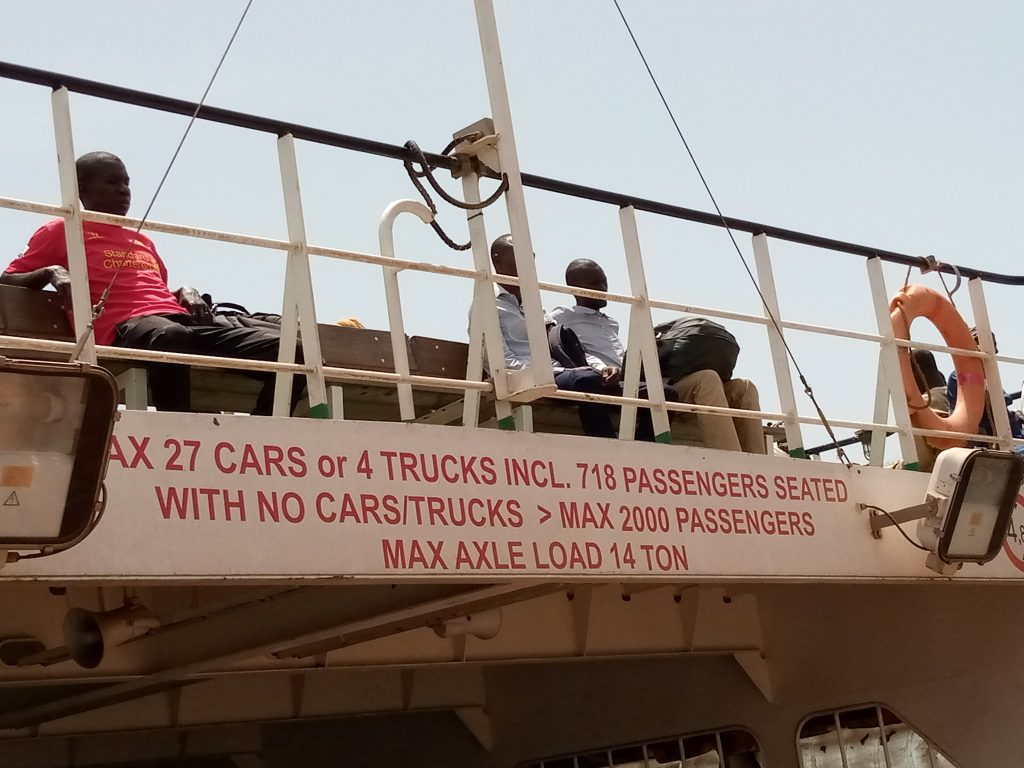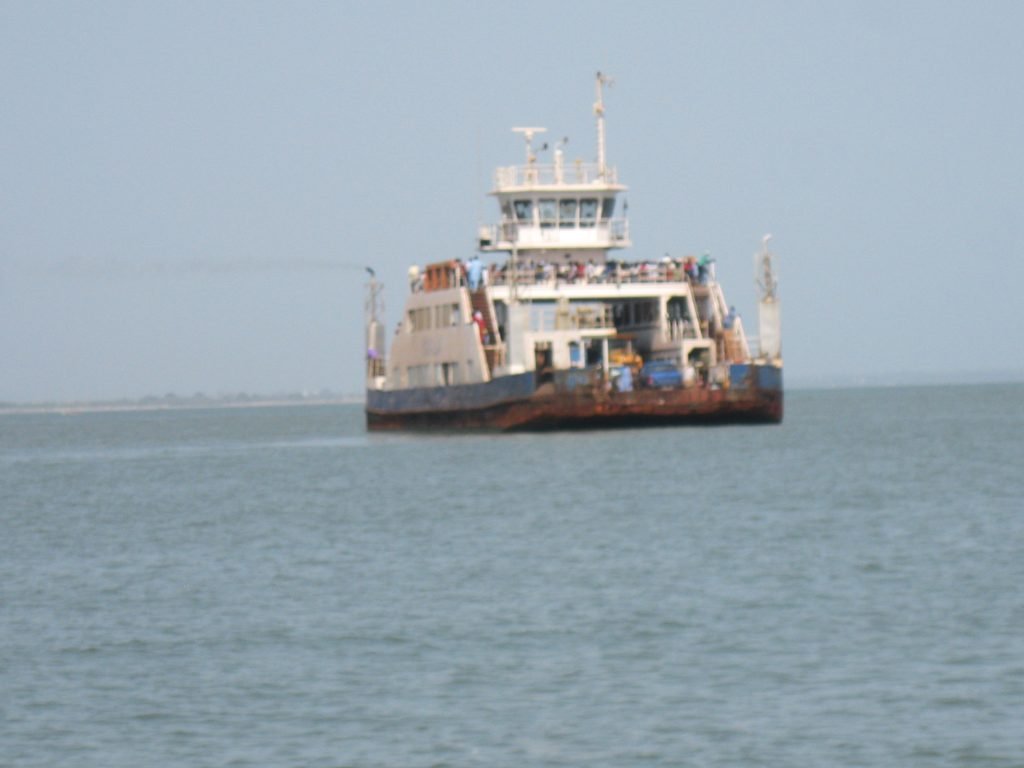By Lamin Jahateh
On Friday, May 10, the Gambia Ferry Service announced that the Kunta Kinteh Ferry is resuming operations, after several weeks of repairs following engine breakdowns.
Both the Kunta Kinteh and Kanilai ferries were withdrawn for repairs in April 2024, after the later’s near-maritime-disaster breakdown on April 12 which left it stucked in the mud off the coast of the River Gambia in the village of Aljamdu – 20 kilometers from its landing spot at Barra.
The Kanilai Ferry is without an anchor on board, according to at least two people familiar with it. In the event of a breakdown at sea, it is usually unable to anchor, leaving the vessel at the mercy of the waves, especially during high tides.
The incident was followed by a massive public outcry with protest being planned at both ends of the River Gambia (the North and the South banks) – forcing the authorities to withdraw them for maintenance.
Not the First Breakdown
The April 12 incident was not the first of its kind.
A year earlier, there was a ferry breakdown of at least 12 hours which even led to the death of one passenger, a patient who was on referral to the Edward Francis Small Teaching Hospital in Banjul.
In 2013, a ferry was stuck in the river with close to 900 passengers from Friday to Sunday.
Would New Engines Solve Breakdowns? No.
Based on our research, the installation of new engines on the ferries does not translate into improvement in services or safety in ferry operations. The April installation of “new engines” on the Kunta Kinteh Ferry is the second time, in less than 30 months.
In January 2022, Kunta Kinteh underwent full maintenance, including the installation of new Caterpillar marine engines (CAT 12). These machines have a lifespan of at least 10 years or 20,000 hours of operation, if properly maintained, according to various online reviews.
Barely after two years of operation during which it registered about 7,000 hours of operation, the engines of Kunta Kinteh became death-old unmanageable. They are replaced with another set of new engines.
In each of these two installations, tens of millions of dalasi are spent to procure the engines and the accessories. In this latest installation, the engines and accessories alone cost more than D80 million (1.2 million euros), according to the Gambia Ferry Services.
With the new engines, Kunta Kinteh has broken down in the river at least 25 times in less than 30 months, from January 2022* (see footnote). These breakdowns consistently led to the inability to anchor at the lander at both sides (Barra or Banjul), and taking long hours to cover a 7-mile waterway (which under normal circumstances should take less than 30 minutes), or even leaving passengers stranded in the river for a whole night with the ferry at the mercy of the waves.

Here is a chronicle of major breakdowns – those breakdowns lasting at least one hour in the river – from January 2023:
- In March 2023, Kunta Kinteh was stranded due to engine-related failure for at least 13 hours in the river. Passengers spent the night on the ferry. It was later found out by Fatu Network that the Gambia Ferry Services misled the public about the reason for this near-fatal incident by saying it was a result of the ferry propeller getting stuck in a fishing net. It “was a lie peddled to cover up the cranky conditions” of the ferry and the bad state of the engines, Fatu Network reported.
- That was the second major incident of Kunta Kinteh in the same month, March 2023. In the first one, the ferry was stranded in the river for several hours with a full load of passengers, according to media reports.
- From March to December 2023, Kunta Kinteh got stuck in the waters due to engine-related faults at least 10 times. There was a major breakdown almost every fortnight.
- In 2024, just in the first three months, Kunta Kinteh engines have failed in the river at least six times. The latest incident was just around mid-March, barely three weeks before the 12th April Kanilai ferry incident. On this ill-fated day, Kunta Kinteh was stranded in the sea for hours; it was eventually tugboated back to Banjul because it could not continue on its journey to Barra.
- There was a similar incident in February this year which was posted on Facebook by a renowned teacher, Musa Bah aka The Scribbler. In a somewhat funny incident, posted by Kebba Camara on Facebook in March, Kunta Kinteh failed to anchor both at Barra and Banjul; it kept whirling in the waters for long worrisome hours before help came.
Since the installation of new engines in January 2022, Kunta Kinteh has undergone maintenance and repairs at least seven times, based on the ferry services record. A huge amount of money was spent on each single maintenance.

The sordid state of Kunta Kinteh points to a poignant picture of the dire situation of the ferry systems operated by the Gambia Ferry Services, which is now subjecting ferry workers to police investigations. Kunta Kinteh is chosen as the focus of this explainer because it is the newest of the fleet of three ferries plying the route. There were days when all three ferries in operation (Johe, Kanilai, and Kunta Kinteh) got stuck in the river with a cumulative total of thousands of helpless passengers.
The Kunta Kinteh ferry was inaugurated in June 2017 with a 10-year warranty. But in just six years, the ferry has become a floating coffin, with the trend of breakdowns showing signs of a possible major maritime disaster waiting to happen.
Foreseeing a possible disaster, the Foroyaa newspaper, the oldest privately-owned publication, had in July 2023 stated in an editorial that “a disaster that is lured cannot be called an accident.”
Based on the above observations, it is fair to say that the endemic engine failure is a systemic issue that will not be solved by random replacement of engines.
Footnote: The number of times the ferry had a problem is curated from official and unofficial sources. Official sources were mainly Gambia Ferry Services’ information and other media reports. The unofficial sources are information posted on social media, mainly Facebook, but also Twitter (now renamed X) by those with firsthand knowledge of the incidents. Before now, the author was a frequent commuter on that route so he experienced a lot of these incidents personally.


